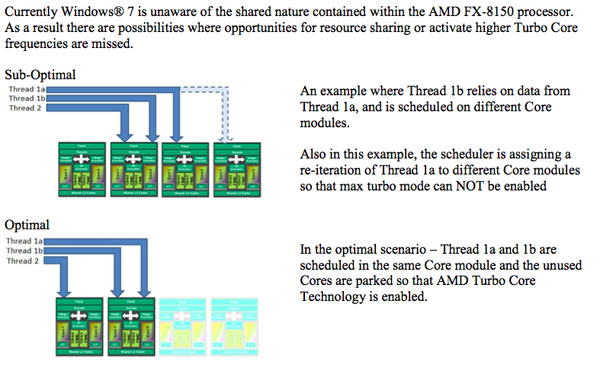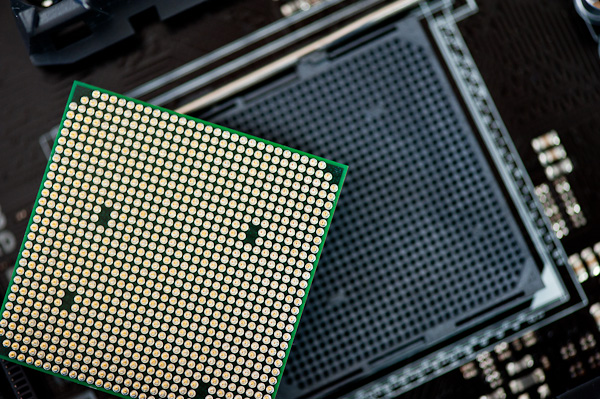The Bulldozer Review: AMD FX-8150 Tested
by Anand Lal Shimpi on October 12, 2011 1:27 AM ESTFinal Words
In many cases, AMD's FX-8150 is able to close the gap between the Phenom II X6 and Intel's Core i5 2500K. Given the right workload, Bulldozer is actually able to hang with Intel's fastest Sandy Bridge parts. We finally have a high-end AMD CPU with power gating as well as a very functional Turbo Core mode. Unfortunately the same complaints we've had about AMD's processors over the past few years still apply here today: in lightly threaded scenarios, Bulldozer simply does not perform. To make matters worse, in some heavily threaded applications the improvement over the previous generation Phenom II X6 simply isn't enough to justify an upgrade for existing AM3+ platform owners. AMD has released a part that is generally more competitive than its predecessor, but not consistently so. AMD also makes you choose between good single or good multithreaded performance, a tradeoff that we honestly shouldn't have to make in the era of power gating and turbo cores.
Bulldozer is an interesting architecture for sure, but I'm not sure it's quite ready for prime time. AMD clearly needed higher clocks to really make Bulldozer shine and for whatever reason it was unable to attain that. With Piledriver due out next year, boasting at least 10-15% performance gains at the core level it seems to me that AMD plans to aggressively address the shortcomings of this architecture. My only concern is whether or not a 15% improvement at the core level will be enough to close some of the gaps we've seen here today. Single threaded performance is my biggest concern, and compared to Sandy Bridge there's a good 40-50% advantage the i5 2500K enjoys over the FX-8150. My hope is that future derivatives of the FX processor (perhaps based on Piledriver) will boast much more aggressive Turbo Core frequencies, which would do wonders at eating into that advantage.

AMD also shared with us that Windows 7 isn't really all that optimized for Bulldozer. Given AMD's unique multi-core module architecture, the OS scheduler needs to know when to place threads on a single module (with shared caches) vs. on separate modules with dedicated caches. Windows 7's scheduler isn't aware of Bulldozer's architecture and as a result sort of places threads wherever it sees fit, regardless of optimal placement. Windows 8 is expected to correct this, however given the short lead time on Bulldozer reviews we weren't able to do much experimenting with Windows 8 performance on the platform. There's also the fact that Windows 8 isn't expected out until the end of next year, at which point we'll likely see an upgraded successor to Bulldozer.

So what do you do if you're buying today? If you have an existing high-end Phenom II system, particularly an X4 970 or above or an X6 of any sort, I honestly don't see much of a reason to upgrade. You're likely better off waiting for the next (and final) iteration of the AM3+ lineup if you want to stick with your current platform. If you're considering buying new, I feel like the 2500K is a better overall part. You get more predictable performance across the board regardless of application type or workload mix, and you do get features like Quick Sync. In many ways, where Bulldozer is a clear win is where AMD has always done well: heavily threaded applications. If you're predominantly running well threaded workloads, Bulldozer will typically give you performance somewhere around or above Intel's 2500K.
I was hoping for Bulldozer to address AMD's weakness rather than continue to just focus on its strengths. I suspect this architecture will do quite well in the server space, but for client computing we may have to wait a bit longer for a more competitive part from AMD. The true culprit for Bulldozer's lackluster single-threaded performance is difficult to track down. The easy answer would seem to be clock speed. We've heard of issues at Global Foundries and perhaps Bulldozer is the latest victim. If AMD's clock targets were 30% higher than Phenom II, it simply didn't make them with the FX-8150. I've heard future derivatives will focus more on increasing IPC indepedent of process technology and clock speed, but if you asked me what was the one limit to success I would say clock speed. As a secondary factor, AMD appeared to make some tradeoffs to maintain a reasonable die size at 32nm. Even then Bulldozer can hardly be considered svelte. I suspect as AMD is able to transition to smaller transistor geometries, it will be able to address some of Bulldozer's physical shortcomings.
The good news is AMD has a very aggressive roadmap ahead of itself; here's hoping it will be able to execute against it. We all need AMD to succeed. We've seen what happens without a strong AMD as a competitor. We get processors that are artificially limited and severe restrictions on overclocking, particularly at the value end of the segment. We're denied choice simply because there's no other alternative. I don't believe Bulldozer is a strong enough alternative to force Intel back into an ultra competitive mode, but we absolutely need it to be that. I have faith that AMD can pull it off, but there's still a lot of progress that needs to be made. AMD can't simply rely on its GPU architecture superiority to sell APUs; it needs to ramp on the x86 side as well—more specifically, AMD needs better single threaded performance. Bulldozer didn't deliver that, and I'm worried that Piledriver alone won't be enough. But if AMD can stick to a yearly cadence and execute well with each iteration, there's hope. It's no longer a question of whether AMD will return to the days of the Athlon 64, it simply must. Otherwise you can kiss choice goodbye.











430 Comments
View All Comments
medi01 - Thursday, October 13, 2011 - link
Slightest "problem" imaginable with AMD GPUs would make it into titles.nVidia article would go with comparing cherry picked overclocked board vs standard from AMD, with laughable "explanations" of "oh nVidia marketing asked us to do it, we kinda refused but then we thought that since we've already kinda refused, we might still do what they've asked".
"Objectively", are you kidding me?
JKflipflop98 - Thursday, October 13, 2011 - link
Anand runs the test, then writes down the number. Then he runs the test on the other PC, and writes down the number.If your number is lower, then it's physics "badmouthing" your precious, and not the site.
actionjksn - Wednesday, October 12, 2011 - link
@medi01 Considering the results I think Anand were more than kind enough to AMD.medi01 - Thursday, October 13, 2011 - link
I recall low power AMD CPUs being tested on 1000Watt PSUs on this very site. How normal was that, cough? iPhones "forgoten in pocket" (authors comment) on comparison photos where they would look unfavourably)Thing with tests is, you have games that favour one manufacturer, then other games that favour another. Choose "right" set of games, and viola...
The move with 1000Watt PSU on 35W TDP CPU is TOO DAMN LOW and should never happen.
On top of it, absolute majority of games is more GPU sensitive, than CPU sensitive. Now one could reduce resolution to ridiculously low levels so that CPU becomes a bottleneck. but then, who on earth would care whether you get 150 or 194 frames per second at a resolution which you'll never use?
Stas - Thursday, October 13, 2011 - link
Not sure what the deal is with PSUs or what article you're referring to. I'm assuming it made AMD power consumption look worse than it was because 1kW PSU was running at 10% load, thus way out of efficiency range. But w/e. My comment is mostly on CPU performance in games. Just because you don't run a game on the top-end CPU with $800 in multi-gpu tandem at lowest settings, doesn't mean it shouldn't be used to determine CPU performance. By making the CPU the bottleneck, you make it do as much as it can side-by-side with the GPU spiting out frames while whistling tunes and picking it's finger nails. There is more load on CPU than GPU. Which ever CPU is faster - that CPU will provide more FPS. Simple as that.Sure, no one will see 20%-30% performance difference using more appropriate resolution and quality settings. But we're enthusiasts, we want to see peak performance difference and extreme loads. Most synthetic tests are irrelevant in everyday use, but performance has been measured that way for decades.
jleach1 - Friday, October 14, 2011 - link
I haven't seen one single sentence that was questionable in a and graphics review. In fact I'm glad to say that I'm a big fan of Intel CPU and and hour combos, and have never had even as much as a hint of bias.As a over exaggeration, in an age where were all stuffing multiple cards in our systems, and cards are efficient, reliable, powerful, and they run cool. yes the drivers have sucked in the past, but they don't really.
(emphasis on the word seem)
NvIdia cards have just seemed clunky and hot as hell since the 400 series. I don't feel like gaming next to a space heater. And I definitely don't want to pay 40 percent more for ten percent performance just to have a space heater and bragging rights.
its like amd graphics are similar to intels CPU lineup, they're great performance per dollar parts, and they're efficient. But NvIdia and Intel graphics are like amd CPUs, they're either inefficient, or they're good at only a few things.
The moral? what the *$&* amd....you might as well write off the whole desktop business if the competition IS fifty percent faster and gaining ground....that 15 percent you're promising next year better be closer to 50 or I'm going to forget about your processors altogether.
jleach1 - Friday, October 14, 2011 - link
Intel CPU and amd combos*....sorry for the bat grammar. Writing on a tablet with Swype.CeriseCogburn - Wednesday, March 21, 2012 - link
40% more cost and 10% more performance?You said that's across the board.
I'm certainly glad you aren't the reviewer here on anything. I mean really that was over the top.
CeriseCogburn - Friday, June 8, 2012 - link
They went fullblown favor the bullsnoozer by using the GPU limited amd hd5870 to make the stupid amd cpu look good.Thank your lucky stars they did that much for you.
MJEvans - Thursday, October 13, 2011 - link
I think your later point is exactly why the FPU support isn't as strong. (most) tasks that use FPU appear to be operating on large matrices of data, while sequential processing seems to have a good design idea (even if the implementation is a little immature and a little early), but slower latency l1/l2 cache access. I hope that's an area that will be addressed by the next iteration.